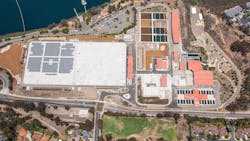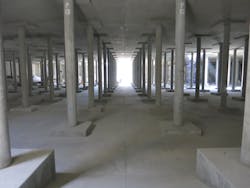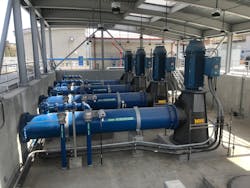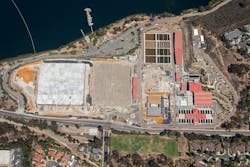The passage of the Clean Water Act (CWA) in 1972 by the United States Congress provided massive investments in water and wastewater infrastructure in the nation. In the 50 years since CWA’s enactment, the infrastructure that once sufficiently served communities is becoming outdated and in need of repair, rehabilitation, or replacement.
Pipelines and treatment plants often have not evolved to meet today’s seismic or structural codes. In many cases, dated water infrastructure is working to serve a population that has rapidly increased — sometimes more than doubling in size. In addition, some areas are facing an increasing number of droughts or stricter regulations.
A case in point is the city of San Diego, Calif. Just 10 years ago, more than half a million customers in the northern portion of the city relied on drinking water from the 60-year-old Miramar Water Treatment Plant, with aging infrastructure that was beginning to deteriorate. At the same time, California was beginning to experience an increasing number of droughts and the San Diego population was booming.
It was clear that the city needed to do something to ensure water security to the public and, in cases like this, there are generally two options to address aging infrastructure: rehabilitate or replace.
Rehabilitate vs. Replace
A water provider’s decision to either extend service of existing assets or replace infrastructure is affected by factors such as life cycle costs, budget, schedule, regulations, and future growth. Further, reliability and redundancy are vital in meeting current drinking water standards.
While rehabilitation can be more cost effective, sometimes completely replacing existing infrastructure is necessary — and, over the long-term, it can be the best solution for the water provider, community, and environment. With advances in design and technology, replacement can mean greater efficiencies throughout the entire life cycle of a water infrastructure project, from design and construction to operation and maintenance.
In San Diego’s case, a thorough condition assessment found that the Miramar Water Treatment Plant would need to replace its clearwells, which suffered from spalling concrete and exposed, corroded rebar. Further, to meet the California Building Code for seismic standards, replacement of these aging structures became the only viable alternative to extend the life of the reservoirs to a 50-year design life.
In June 2016, the city embarked on a highly complex, four-and-a-half-year construction project that would improve efficiency and overall system redundancy to meet growing demand and tightened regulatory requirements. The Miramar Clearwell Improvements Project became the top project in the City of San Diego Water Capital Improvements Program Master Plan prioritization, and, at $120 million, is the largest current capital improvement project for the city.
Miramar Clearwell Improvements Project
First constructed in 1959 and operational in 1962, the Miramar Water Treatment Plant and its original sole water storage reservoir, Clearwell 1, served the newly developed regions of San Diego. In 1974, the plant was expanded, and Clearwell 2 was built. It was expanded again in the 1980s and once more in the early 2000s.
Located adjacent to a reservoir, the plant is one of San Diego’s three water treatment facilities that supply treated water to the now hundreds of thousands of residents living in San Diego’s north county.
With the two aging clearwells reaching the end of their service lives — and neither designed for modern seismic codes — the city took action to prevent the potential failure of the infrastructure that threatened to compromise the water distribution system.
In 2011, the city initiated the design of two new rectangular-shaped clearwells. During the original clearwells planning process, city engineers noted the need for further redundancy in case of a power outage affecting the ozone disinfection process, as well as the need to upgrade hydraulics.
In 2012, the City of San Diego Public Utilities Department partnered with Kleinfelder — an engineering, design, and construction management firm — to help tackle the project. Serving as the prime consultant providing engineering management, design, and construction support services, Kleinfelder began working with the city and stakeholders to identify the best course of action and key project milestones for this massive undertaking.
The project substantially improved upon the original 1959 facility. In addition to replacing the two aging finished water storage reservoirs, the project included replacement of approximately 600 linear feet of the existing 48-inch Miramar Pipeline, addition of a dual-train chlorine contact chamber, a 215 million gallon-per-day (MGD) low-lift pump station, a new operation and maintenance facility, new guard house and security system, an electrical building, and a 2 megawatt (MW) solar system.
Adding to the challenge of the project’s magnitude and technical complexity was the requirement to complete each phase of the project while maintaining uninterrupted service to over 600,000 customers. The project team also had to consider strict requirements for dust control and construction stormwater discharges, minimize impacts to daily community use of the Miramar recreation area, and address an active and vocal community of stakeholders.
Harnessing Advances in Technology and Design Innovation
A key advantage of replacing aging infrastructure is the enhanced reliability and efficiency that new infrastructure provides. Because of this, the Kleinfelder design team were able to employ several design innovations and technologies to help develop the project.
Use of Visualization Tools
As part of the initial design and to support community outreach efforts, Kleinfelder used state-of-the-art 3D building information modeling to render construction and model the interim milestones (Maintenance of Plant Operations) and finished facilities. The modeling and animation of existing and future conditions helped provided vital information to the designers, the contractor, and the community about the planned improvements, including critical calculations.
Without this model, stakeholders would have been reliant on traditional record drawings and data with labor-intensive calculations, analysis, and computations. The investment in this graphical representation proved useful in making changes, modifying the construction sequence, and achieving project acceptance within the community.
Creative Construction Sequencing
The construction of the new clearwells required the loss of one operating clearwell for a significant period, which was a substantial challenge for operations. To always maintain operation of one clearwell, the Kleinfelder team carefully planned construction sequencing for clearwell construction and piping.
The sequencing included the independent isolation of the clearwells for pipeline and vault construction, with shoring to protect the pipelines and the remaining clearwell during construction. In addition to the multiple challenges — such as seasonal plant demand and limitation — the sequence of construction (a critical risk management issue) was organized to maintain the availability of at least one continuously operating clearwell.
Design Efficiencies
The new seismically-compliant clearwells helped reduce the size of the chlorine contact chamber. This resulted in more storage capacity, reduced ongoing maintenance costs, better control for steady distribution, less production fluctuation impact to the plant operations, and critical inactivation functionality through chloramines in various water quality conditions — especially if both the ozone and chlorine contact chamber were offline together.
System Optimization
A key part of the Miramar Clearwell Improvements Project was the construction of a new chlorine contact chamber. To meet and exceed the U.S. Environmental Protection Agency’s drinking water standards, this project included the design and implementation of a disinfection system that encompassed all conceivable water quality and operating conditions to provide a high level of reliability and drinking water quality to its constituents.
The objectives of the chlorine contact chamber included adding redundancy and reliability to the current ozone system. This was done by using free chlorine disinfection within the chlorine contact chamber, thus eliminating the addition of chlorine to the filters and converting filtration to a biological mode. The new chamber proactively enhanced the water quality in the distribution system in anticipation of increasingly stringent regulations.
Sustainable Design
In support of the City of San Diego’s commitment to sustainability and green design, Kleinfelder worked to develop as many sustainable features and practices as possible — from reuse of materials, such as the concrete from the original clearwells, to the photovoltaic solar power generating system installed on the top of Clearwell 2, plus a photovoltaic switchgear to provide additional solar photovoltaic cells on the top of Clearwell 1 (which will be installed as part of the city’s Pure Water program in the future).
Prioritizing Renewal of Water Infrastructure
While the cost of replacement may impact planned spending in other areas, patchwork and marginal actions today will only lead to even larger challenges tomorrow. These projects present an opportunity to leverage advanced technologies and innovations in design to greatly enhance the efficiency, efficacy, sustainability, and reliability of water distribution systems.
By taking a proactive approach to addressing aging infrastructure, the City of San Diego’s investment in the Miramar Water Treatment Plant provided advanced flexibility in operation, maintenance, and disinfection, culminating in the plant’s ultimate capacity of 215 MGD. The plant can now respond to changing water quality conditions with full redundancy and reliability to its customers, and will ensure the safe delivery of clean, potable water for decades. WW
About the Author: Simon Wong, PE, SE, is a vice president of major accounts at Kleinfelder and has more than 37 years of experience providing professional services in water/wastewater, pipeline, treatment facilities, and water structures such as pump stations and reservoirs to the City of San Diego.
Published in WaterWorld magazine, June 2022.
About the Author
Simon Wong
Simon Wong, PE, SE is a vice president of major accounts at Kleinfelder and has more than 37 years of experience providing professional services in water/wastewater, pipeline, treatment facilities, and water structures such as pump stations and reservoirs to the City of San Diego.




